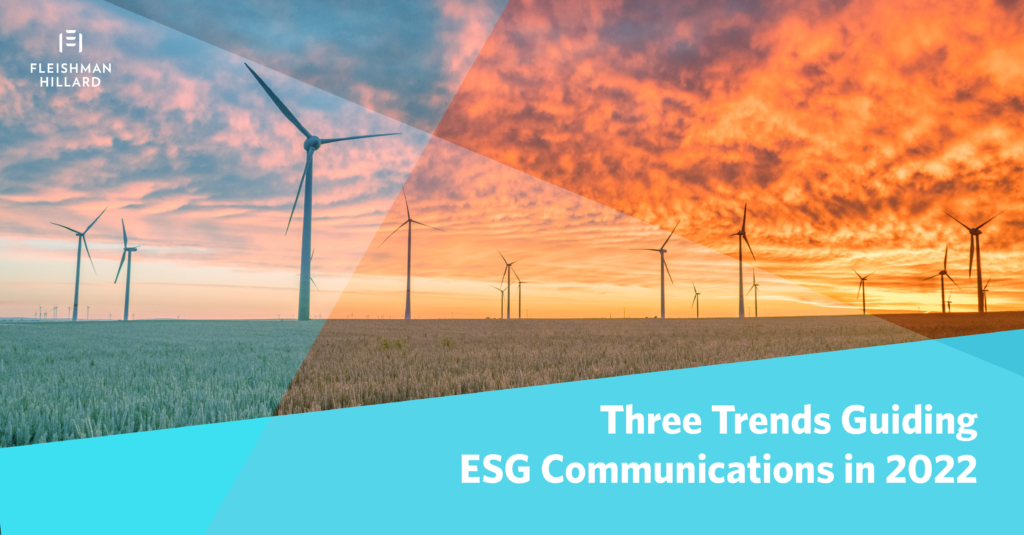Three Trends Guiding ESG Communications in 2022
As we approach the midpoint of Q1, many brands are starting to execute on their ESG agendas for 2022. More than ever before, stakeholders are seeing ESG as a business practice key to profit and reputation. As the stakes for ESG continue to rise, here are three trends for communications professionals to keep in mind.
As Brands Rush to Net-Zero Commitments, Accountability Remains a Priority
Over 200 companies have pledged to reach net-zero emissions by 2040, including nearly 90 companies who set new targets timed with Climate Week in September 2021. Similarly, while a focus on regenerative agriculture used to be limited to the start-up community, many big-name brands are following the lead of Certified B Corp companies in committing to new ways of farming. Following a recent U.N. panel that U.N. Secretary-General António Guterres called a “code red for humanity,” brands seem to be racing to get in line to tout their commitment to reaching a sustainable future.
However, many pundits left COP26 in Glasgow frustrated, believing that without an accountability framework, pledges will be difficult to measure and may prevent stakeholders from holding brands to account for their ESG commitments. Limited transparency and an overreliance on carbon offsets may prevent us from reaching the targets necessary to avert catastrophe. As GreenBiz chairman and co-founder Joel Makower argued last year, “Given the lack of policy or standardized guidance driving net-zero commitments, not to mention the loopholes through which many companies seem to be leaping, there’s pretty much a net-zero chance that they will, collectively, meet the goals of the 2015 Paris Agreement — at least, not without some significant changes.” Communications leaders can buck potential criticism and accusations of greenwashing by pairing their ESG goal messages with a roadmap for how they’ll reach their targets and by clearly defining what concepts – like regenerative agriculture – mean to them.
Anticipated SEC ESG Disclosure Requirements will Mandate Transparency
Following the lead of the European Union, the SEC is preparing to release new disclosure requirements that will require publicly traded companies to openly share their progress on environmental and social initiatives. While the details behind the SEC proposals are still under development, brands will need to ensure reporting across all communications channels is consistent and allows stakeholders to quantitatively compare the ESG performance of disparate companies. Noting that the disclosure requirements for climate change are rumored to come first, sectors with large carbon footprints – including the food and agriculture sector – may be forced to serve as a guinea pig.
Once enacted, the disclosure requirements will likely up the ante on expectations investors and other stakeholders have for ESG performance. Getting ahead of this and building transparency into 2022 ESG communications plans is a key opportunity that could allow brands to take a leadership position. On the other hand, waiting for the disclosure requirements to be announced will push brands into a reactive position wherein it is unlikely they’ll get credit for the steps they’re taking to become more transparent.
With Pressure to Account for Scope 3 Emissions Intensifying, Industry Stakeholders Need to Collaborate on ESG
In late January, the California state Senate passed a bill that would require corporations with more than $1 billion in annual revenue to disclose all scopes of their greenhouse gas emissions to the California Secretary of State’s office. The bill emphasizes the importance of acknowledging a full emissions footprint, including Scope 3 emissions, which represent emissions associated with value chains and the consumer use of a product.
As taking a more holistic look at emissions through the supply chain become de rigueur, industries with extensive, global value chains – such as the food and agriculture sector – will face the greatest challenges. With large grocery retailers pledging to slash the greenhouse gas emissions in their supply chains, producers are feeling heightened pressure to get their emissions in order. Communications leaders should view supply chain partners as a key audience and ensure they’re taking steps to support suppliers as they work toward their ESG commitments.
It is critically important that the business community work together to achieve climate goals. Stakeholders in each sector must see each other as partners in promoting environmental impact. Vilifying entire industries is not a helpful tactic and takes energy away from the positive actions required to avoid the disastrous effects of climate change. Within the agriculture industry, leveraging new innovations and proven techniques will be vital to meet global food security and protein needs while protecting our shared planet.
It is safe to say that 2022 will be a landmark year for ESG communications. Approaching these new demands for accountability, transparency and engagement through the supply chain provides a strategic communications opportunity – and a business opportunity – for companies and brands.

